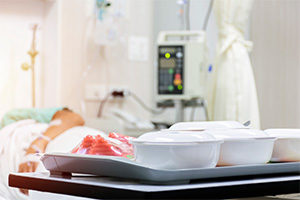Interventional Care


We notice that you are visiting us from . This site only services US-based visitors. Would you like to visit the site that is appropriate for your location?

Despite well-established safe food handling practices, foodborne illness remains a significant source of morbidity and mortality in the United States1 and represents a strain on the healthcare system. Hospitalized patients are particularly susceptible to foodborne illness with an increased risk of severe complications. Vulnerable groups, such as pregnant women, young children, elderly people and people with a weakened immune system as a result of illness, treatment or medication2, have been estimated to comprise around 20% of this population3. With around 9.4 million episodes each year, foodborne illness represents a strain on the healthcare system. An estimated 56,000 people are hospitalized each year due to foodborne illness 4. A high number of patients hospitalized with foodborne illness may represent an epidemiological risk in the healthcare setting due to cross contamination of environmental surfaces and medical devices and/or the unwashed hands of healthcare workers.
Outbreaks of norovirus are a prime example of a low infectious dose, a difficult to inactivate pathogen that can spread via environmental or person to person contact. Members of the Clostridium genus can also have a substantial negative impact on a hospital. Clostridium difficile, Clostridium botulinum and Clostridium perfringens have all been implicated in foodborne outbreaks because of their heat resistance and ability to survive in the environment for several months 5. Controlling the spread of disease from a hospitalized patient becomes paramount to preventing a major outbreak within the facility.
In addition, one has to consider the role of cross contamination from asymptomatic or mild symptomatic food preparation workers in a healthcare setting. At a time when healthcare is transitioning to a hospitality model, an on-demand, customized menu represents a higher level of risk from an increased variety of food and food handling steps in the kitchen. More research is needed to understand how the benefits of a patient dining experience outweighs the potential impact of serving high-risk foods and an increase in food handling.
Case Studies
A 2010 outbreak of Clostridium perfringens at a Louisiana State Psychiatric hospital was described in the CDC’s Morbidity and Mortality Weekly Report (MMWR)6. In this case, 42 patients and 12 staff members experienced vomiting, abdominal cramps and diarrhea. Three of the patients died as a result of the illness, with two of the deceased found diagnosed with necrotizing colitis. The investigation found that chicken served to the patients and staff contained C. perfringens enterotoxins matching that of the stool samples taken from the affected patients and members of staff. The suspected meal was cooked and cooled slowly in a manner contrary to hospital guidelines, with a temperature check not conducted until 16 hours later. The chicken was removed from cooling three times for preparation as a cold chicken salad or cold chicken sandwiches.
A mixed outbreak of Campylobacter jejuni and Salmonella Heidelberg was reported in 1997 in a Brooklyn, New York nursing home7. Of the 119 residents who developed illness, 93 symptomatic patients submitted stool samples and tested positive for Salmonella Heidelberg (24) or C. jejuni (14) or both (25). Among the foods served 5 days prior to the outbreak, five meat or poultry items were associated strongly with positive cultures. It was reported that a food handling error occurred when ground cooked chicken livers were placed in a bowl containing raw chicken liver juices.
In my research there were multiple accounts of Listeriosis outbreak investigations, presumably because of their high mortality rate. One such case examined a prolonged 7 month outbreak in 5 Texas acute care hospitals8. The researchers traced the source of the outbreak from 10 patients (5 deaths) to diced celery used in various dishes including a cold chicken salad. The source of the contaminated celery was determined to be a food processing plant based on PCR testing of the environment and food samples isolated from culturing. In this case, the processing plant was shut down and the celery recalled.
Prevention Guidance
There are a number of excellent food safety guides available from the FDA, CDC and U.S. Department of Health and Human Services. Most focus on the safe cooking and handling of foods that can be applied to any situation where food is being prepared. The choice of a food safe sanitizer or disinfecting sporicide and reduced reliance on reusable towels is essential to reduce cross contamination. Hygiene of food handlers cannot be stressed enough and is recognized by the FDA Food Code, which provides more stringent requirements for employees working in food establishments that serve highly susceptible people (https://www.fda.gov/food/fda-food-code/food-code-2017).
Other organizations provide advice on neutropenic or low-microbial diets for high risk patients 1,2,9. These diets restrict the use of raw foods and unpasteurized dairy products, while promoting the use of canned foodstuffs, well-done meats and well washed or frozen vegetables. While not sterile, the use of these foods lowers the risk of foodborne infection especially to susceptible patients.